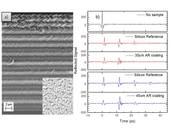Highlight
Nanostructured Porous Silicon Films for Terahertz Optics
Achievement/Results
The NSF sponsored IGERT trainee Michael Riley and his collaborators at the Center for Terahertz Research and Nanostructure Thin Film Lab, Rensselaer Polytechnic Institute, Troy, NY, have created 30 and 45 micron thick, graded index Si films in the form of nano-spirals on Si substrate using dynamic oblique angle deposition technique. An effective refraction index of 2.1 and 1.9 were extracted from the terahertz time domain reflectivity data, which corresponds to 57% and 51% porosity for the 30 and 45 micron thick films, respectively. The gradient of porosity through the film was modeled to describe quantitatively the terahertz reflectance data. The feasibility of using such a film as THz antireflection coating in the 0.2 to 2.0 THz regime was explored.
Figure 1a shows an SEM cross-sectional and top-down (inset at the bottom right) images of the 30 μm thick Si spiral film. The success of producing such a thick film without delamination from the Si substrate is primarily due to nano-porous nature of the film which effectively eliminates the stress generated during growth. The Si spiral film was grown under oblique angle deposition with substrate rotation. In this technique, films are deposited with the incident flux aligned at an angle with respect to the substrate surface normal while the substrate is rotating with a constant speed. At deposition conditions where there is limited surface diffusion, islands of different heights are nucleated on the surface. Initial taller islands would obstruct or shadow the flow of incident flux to other areas near the islands that have a lower height. This causes the morphology to deviate from the smooth and regular surface that results in porous film. The 30 μm has 6 layers starting from the bottom (substrate) with different oblique incident angle ranging from 70 to 85 degrees from substrate normal and corresponding thickness ranging from 3 μm to 6.8 μm. The rotational speed is 0.025 rotations per min.
The optical properties of the films were characterized by reflection measurements using the terahertz time-domain spectrometer. It had a useful signal-to-noise ratio in the range from 0.2 to 2 THz with the high frequency end corresponding to a wavelength of 150 μm. Figure 1b shows the average of 30 time-domain scans of the reflectance spectra for the 30 μm and 45 μm films. Multiple peaks are evidence that the signal has multiple backside reflections within the sample. The amplitude of the first peak is smaller in the coated samples as compared to that of the uncoated sample indicating that the coated samples have a higher transmission. The reflectance spectra from 0.2 to 2 THz were obtained for the coated side of the films, showing strong anti-reflection reaching below 0.7% at 1.6 THz for the 30 μm coating and 1.0% at 1.05 THz for the 45 μm. A model assuming a linear index gradient was used to calculate the reflectance spectra and was seen to describe quite well the experimentally measured data (not shown here).
This finding indicates that with appropriate design and optimization, the oblique angle deposition technique has the potential to fabricate efficient broadband anti-reflection coatings for THz devices.
Address Goals
In the process of measurements of THz time domain reflected spectra and the growth of Si spiral film the IGERT trainee and collaborators learned to work together and developed skills complementary to each other as well as disseminated findings to society through professional conferences such as annual Industry Days for the Smart Lighting Energy Research Center, Boston University, Boston, MA and RPI Venture Summit, Troy, NY.






